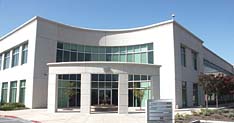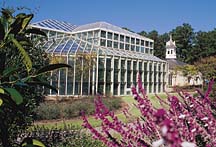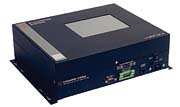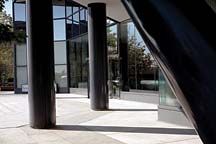Answer: Each facility turned to a building automation system (BAS) to help in their respective HVAC concerns and help reduce energy costs.
The same can be said of SRI International — an independent, nonprofit research institute, located in Menlo Park, Calif. — and One Bellevue Center, where lighting and energy management had to be integrated into this Bellevue, Wash., building’s control system in order to cut back on energy costs and provide better HVAC control of the facility.

Case One — Deltagen Inc.
To house its vivarium, Deltagen Inc. recently retrofitted approximately 100,000 square feet of an office building on its three-building campus. The challenge was to provide precise ventilation and temperature management in this highly sensitive laboratory environment.Deltagen, considered one of the leading providers of drug discovery tools and services to the growing biopharmaceutical industry, offers a suite of programs designed to enhance the efficiency of drug discovery and metabolism technologies. To maintain air quality, large volumes of fresh outside air had to be continually brought in and then exhausted. Recirculating or mixing air was not an option. But moving large quantities of air posed a challenge.
Incoming and exhaust airflow had to be delicately balanced to achieve proper pressurization within the rooms. And, of course, the complex network of HVAC equipment needed to operate flawlessly — 24 hours a day, seven days a week — to provide a stable environment.
Looking At All Avenues
Deltagen approached the northern California office of Western Allied, a design-build contractor with expertise in biotech facilities, to design and install the sophisticated building automation system. Western Allied, headquartered in Santa Fe Springs, Calif., has been designing, constructing, retrofitting, and maintaining HVAC systems throughout California since 1961. Western Allied had been involved with a number of projects at Deltagen and had a close working relationship with the biotech firm.To conserve energy, Western Allied proposed a system of chilled-water pumps, piping, and coils to recover heat from the exhaust air-stream and heat up incoming outside air. This technique would substantially reduce the cost of heating or cooling the massive amounts of air entering the vivarium.
Western Allied’s next challenge was to select a BAS capable of detailed monitoring. The optimal system would be both easy to install and manage, and could be expanded in the future.
The company solicited bids from two suppliers with proprietary BAS solutions. While discussing these bids with Deltagen, Western Allied proposed another solution — an open, nonproprietary system based on LonWorks from Echelon (San Jose, Calif.). Western Allied is an authorized Echelon Network Integrator and Open Systems Alliance (OSA) member. All three bids were within a similar range, but long-term costs and other factors important to Deltagen favored the LonWorks solution.
“Cost was a big factor,” said Mark Watson, director of facilities for Deltagen. “The ability to add or remove components, make changes to the system, and reprogram it — all those can be done in-house with the LonWorks solution. We’re not locked into hiring one proprietary vendor. That was one of the major selling points. A nonproprietary system was what we were looking for.”
Watching The Charts
Installation of the system was completed in December 2002, with final commissioning taking place earlier this year. The LonWorks-based building management system closely monitors the temperature and airflow throughout the building and controls each of the variable air volume (VAV) valves and variable-frequency drives (VFDs). It also monitors virtually all of the HVAC components, as well as steam boilers, process chillers, vacuum pumps, and air compressors.A 280-horsepower supply fan plant brings outside air into the building. Nearly 250 VAVs and 11 VFDs regulate the flow of air into and out of the rooms. Meanwhile, 39 “smart controls” — EC230 I/O programmable controllers connected to nine subnets, each with an Echelon LonPoint LPR-12 Router Module — manage these VAVs and VFDs.
The system has been programmed to provide two levels of alarms. The first level is an alert, which sends an e-mail message to Watson. Alerts are not emergencies and do not require immediate action. During the second level of alarm, a service emergency, a text message is sent simultaneously to Watson’s cell phone and to Western Allied, which is contracted to provide support and dispatch a service technician immediately.
LonWorks technology enables Western Allied to monitor the system remotely from its network control center using PCAnywhere software and a secure, virtual private network (VPN) connection. Watson has the option of setting up the same type of connection from home, but because he lives so close to the office, he has not yet done so.
According to Watson, the LonWorks network architecture enables new devices to be added easily. Deltagen plans to add more components to its LonWorks-based BAS in the future.
“We expect to tie in some cryostorage and minus-80 freezers, providing temperature monitoring,” said Watson.

Case Two — Callaway: Gardens, Resort, Preserve
With its own central chiller plant, water treatment plant with domestic water distribution, sewage treatment system, and backup power generation, Callaway: Gardens, Resort, Preserve is a city in itself. Managing the resort enterprise and all of its assets is a challenge.Callaway includes a 14,000-acre garden; a golf resort, which includes 800 guest rooms in its hotel, villas, and cottages; an 18,000-square-foot butterfly center; a 35,000-square-foot executive conference center; and a newly opened 35,000-square-foot meeting facility with ballrooms and a restaurant, lounge, and kitchen.
With all of these services and amenities, the engineering employees were spending a significant amount of time traveling between facilities and responding to menial service calls and alarms. This diminished their ability to proactively manage the facilities. They needed to implement a more efficient process.
At the same time, the energy expense was another concern for Callaway, as it was spending several million dollars annually with an aggregated peak demand of approximately 40 mW.
Callaway wanted to implement aggressive demand-limiting sequences to reduce peaks and lower costs, but needed to integrate electric metering devices with various automation systems.
Challenge And Solution
Each of Callaway’s numerous automation systems had a dedicated and cumbersome user interface that could only be accessed from the Callaway control center. Many times maintenance staff members would return to the control center after a service call, only to find they needed to visit a building in the same area they had just left to make lighting or temperature adjustments.In addition to control systems, electric meters needed to be integrated with other systems for electric-demand limiting. To implement this without affecting comfort meant Callaway would have to look for reductions beyond traditional HVAC and lighting systems.
In the end, it chose Vykon by Tridium (Richmond, Va.) to meet its needs. According to the manufacturer, Vykon is an open technology designed to integrate diverse systems into a unified network. Because it is a thin-client, Wed-based suite, anyone with proper security clearance can access the system. This allowed Callaway to delegate basic lighting and temperature adjustment calls to administrative staff, thus freeing up the engineering resources.
In addition, response time improved, as the Web-based suite allows employees to make appropriate changes from any computer on their network. Also, maintenance travel time was reduced as the system was configured to send real-time alarms, allowing resources to be dispatched within geographical areas versus repeated roundtrips to the control center.
“Using Vykon, we have been able to lower expenses while increasing productivity,” said Cliff Strickland, Callaway’s engineering manager, mechanical. “Running something the size of a city, this product has allowed us to do more with less.”
The system also enabled a sophisticated demand-limiting program. In addition to shedding electric load through HVAC and lighting systems, Callaway integrated its golf cart-charging system. Carts previously were charged when returned, and the resort staff recycled carts throughout the day. Applying demand limiting on the cart-charging system guarantees Callaway will not be charging carts during costly periods, said Strickland. “We needed to get creative,” he said.
Since the installation, Callaway has reduced energy consumption at crucial times. According to Strickland, the peak kW usage has been reduced by over 30 percent in areas where demand limiting has been implemented. Response time has improved and technical re-sources are more efficient, he said. In addition, he said the payback on its investment was less than a year and the company continues to expand the system and generate additional savings.

Case Three — SRI International
As an independent, nonprofit research institute, SRI International conducts client-supported research and development for government agencies, commercial businesses, and nonprofit foundations. Its 63-acre main campus in Menlo Park has more than 1 million square feet of space, including 250,000 square feet of research labs.After the institute concluded that inefficient energy distribution was a primary cause of rising costs, it went in search of new control system technologies to provide more precise control over building operations and to minimize energy use. To meet its complex requirements, SRI selected the StarView WebAccess control system from Barrington Systems (San Carlos, Calif.) to monitor and control its 1.3 million square feet of building space.
This system enables SRI to predict future utility needs based on current data gathered from several thousand remote points. This anticipatory nature allows SRI to plan tasks in advance and make better use of energy resources.
“With Barrington’s system, we can actually strategize our energy use based on real-time data from the controlled devices and from the utility company. This gives us the tools to take a proactive approach to system control,” said Mario Rosales, SRI’s facilities engineer.
How It Works
Using a standard Web browser, users can view and control building automation or other monitoring and control systems. Additionally, all configuration and deployment is performed through a standard Web browser including I/O configuration, graphics building, LanStar control programming, and network management.The distributed direct digital controllers (DDC) are fully Web-enabled. Communication between the various SRI buildings is now handled over the site-wide Ethernet network. DDC programming of the LanStar system is done using a simplified “block oriented” controls editor. Control blocks may be edited remotely from any place that there is Internet access. In the end, this allows Barrington’s technicians and applications engineers to remotely assist SRI engineers with system modifications and control strategy enhancements.
SRI takes advantage of the interoperability features of the WebAccess system by communicating directly with York chillers. Using the industry standard Modbus communications protocol, all real-time operational data is incorporated into WebAccess, allowing full control and online diagnostics. The system is designed to make sure that the chiller plant is operating at maximum efficiency.
Also, SRI facilities engineers use WebAccess’ “Thin Client” capacities to access the system using pocket PCs from anywhere on site through wireless communications. With SRI’s sprawling campus, being able to control the system remotely greatly improves manpower efficiency.
The Thin Client interface supplies snapshots of dynamic graphics. Real-time data, alarms, and changes to data are supported. With appropriate passwords, users can view displays assigned to them, change setpoints, start or stop equipment, enter data, acknowledge alarms, and perform any control action.

Case Four — One Bellevue Center
One Bellevue Center is considered one of the premier business addresses in one of Washington’s largest cities, Bellevue. The 22-story building offers 430,000 square feet of space to some of the area’s investment firms and software businesses.With chillers on every floor, the building had a great deal more mechanical controls than other buildings of similar size. Lighting and energy management had to be integrated into the building control system in order to cut back on energy use and provide better control of the facility.
Lynnwood, Wash.-based contractor Northwest Air was called in to install the controls system from Delta Controls (headquartered in Surrey, British Columbia) in more than 20 mechanical rooms. Close to 700 VAVs were incorporated into the system, as were more than 20 A/C units and air-to-water reciprocity units. Even garage exhaust fans and lighting and energy management were integrated into the building controls system.
“In my eight years with the building, we’ve never experienced a single crash. Reliability has been superior. Our system works like a champ,” said Dale Johnson, building engineer at One Bellevue Center.
“I work with four buildings and Delta’s graphics are so much more fun to work with,” he said. “I can program the system myself, and they offer incredible diagnostics directly from the screen.”
Operational costs were reduced, and the building recently earned an Energy Star Building Award for energy conservation.
Publication date: 10/06/2003

Report Abusive Comment